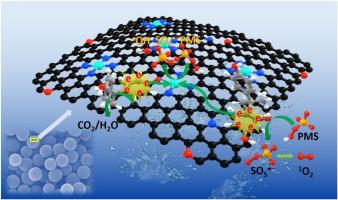Applied Catalysis B: Environment and Energy ( IF 20.2 ) Pub Date : 2021-01-21 , DOI: 10.1016/j.apcatb.2021.119912 Hongxiang Zhang , Lai Lyu , Qian Fang , Chun Hu , Sihui Zhan , Tong Li

|
Orbital interaction involving metal cation−π is an important form for electron transfer regulation. To accelerate the interfacial electron transfer of peroxymonosulfate (PMS) activation for water treatment, we report a new strategy through bonding atomically dispersed cobalt with nanospheric C-based graphene-like structures (SACo-NGs) to form metal cation−π structure, driving rapid and directional transfer of the electrons of pollutants to PMS on the catalyst surface. The catalyst SACo-NGs is synthesized by an enhanced hydrothermal-sintering method and the formation of metal cation−π structure is demonstrated by X-ray absorption fine structure (EXAFS), X-ray photoelectron spectroscopy (XPS), electron paramagnetic resonance spectroscopy (EPR) and Raman spectroscopy. It is found that Co−π structures (Co2+-N-Cπ) play a key role for the efficient activation of PMS, which results in pollutants being greatly removed in a few minutes. During the reaction, pollutants can donate electrons for the system through π−π interaction accompanying by the direct oxidative degradation of pollutants. The obtained electrons are quickly transferred to the atomically dispersed cobalt sites through the formed cation−π structure, which promotes the activation of PMS. This is a successful practice in the field of PMS activation using cation−π structure to accelerate electron transfer and achieve rapid degradation of pollutants.
中文翻译:

阳离子-π结构诱导过氧化单硫酸盐的有效活化,从而在原子分散的钴键合石墨烯状纳米球上降解污染物
涉及金属阳离子-π的轨道相互作用是电子转移调节的重要形式。为了加快过氧单硫酸盐(PMS)活化的界面电子转移以进行水处理,我们报告了一种新的策略,该方法通过将原子分散的钴与纳米球形C基石墨烯样结构(SACo-NGs)结合以形成金属阳离子-π结构,从而迅速发展以及污染物电子向催化剂表面PMS的定向转移。通过增强水热烧结法合成了催化剂SACo-NGs,并通过X射线吸收精细结构(EXAFS),X射线光电子能谱(XPS),电子顺磁共振光谱( EPR)和拉曼光谱。发现Co-π结构(Co 2+ -NCπ)在有效激活PMS中起着关键作用,这导致污染物在几分钟内被大量清除。在反应过程中,污染物可以通过π-π相互作用(伴随污染物的直接氧化降解)为系统贡献电子。获得的电子通过形成的阳离子-π结构快速转移到原子分散的钴位点,从而促进PMS的活化。这是在使用阳离子-π结构的PMS激活领域加速电子转移并实现污染物快速降解的成功实践。






























 京公网安备 11010802027423号
京公网安备 11010802027423号